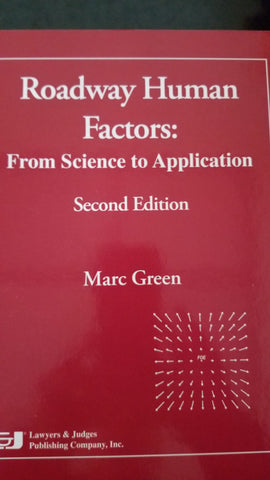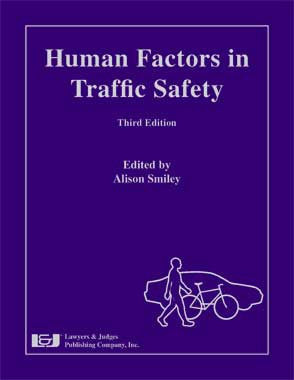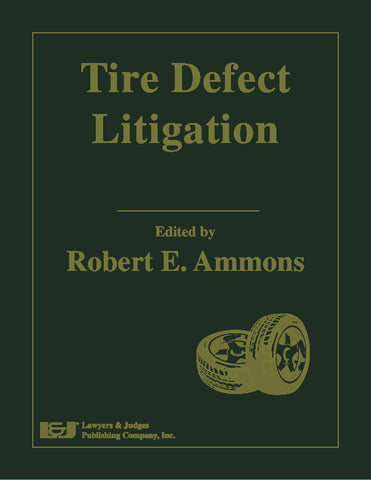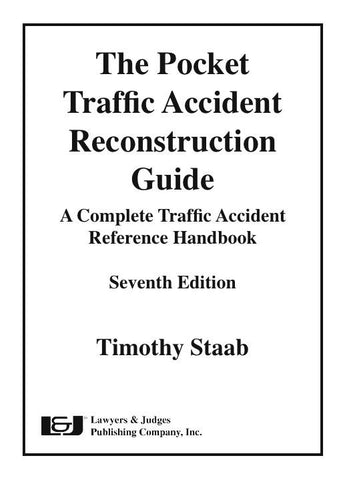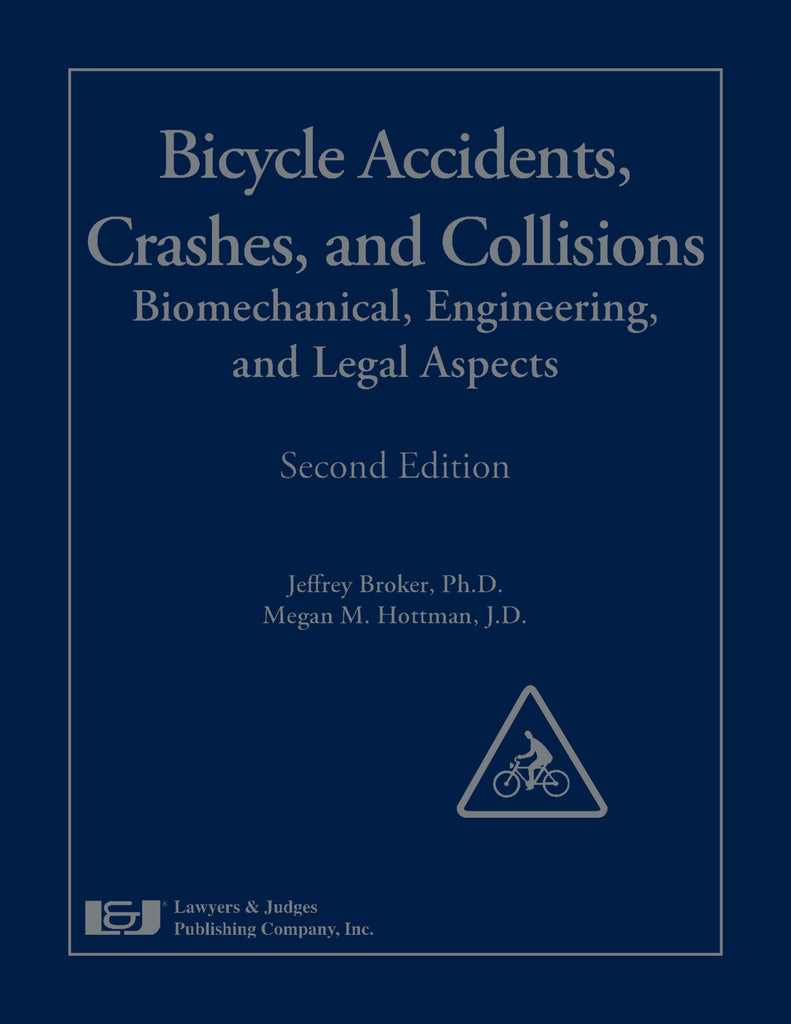
Bicycle Accidents, Crashes, and Collisions: Biomechanical, Engineering, and Legal Aspects, Second Edition
-
Editors: Jeffrey Broker, Ph.D. and Megan M. Hottman, J.D.
-
ISBN 10: 1-936360-58-6
-
ISBN 13: 978-1-936360-58-1
-
Copyright Date Ed: August 24th, 2016
-
Pages: 384 pages
-
Binding Information: Casebound
- Size: 8.5 ✕ 11 Inches (US)
In the all new Bicycle Accidents, Crashes, and Collisions: Biomechanical, Engineering, and Legal Aspects, Second Edition you will learn about many different aspects of bicycle accidents, crashes, and collisions, and the legal issues surrounding them. The authors present a wealth of information including such topics as the physical and operating characteristics of bicycles, cyclist's rights and duties, accident types, insurance and liability issues and bicycle regulatory information, including the Uniform Vehicle Code and State Bicycle Statutes. The Second Edition is newly updated with expanded discussions, and now in a revised, two-column format.
The book is divided into two parts for easy access to pertinent information. Part one discusses many of the physical and mental aspects of operating a bicycle. You will learn about topics such as the cycling setting, crash tests, bicycle types and designs, visual perception and response, equipment failure, biomechanics of cycling injuries, pitch-over cycling accidents, and cycling helmets. Part two covers the legal aspects of operating a bicycle and of liability, both of the cyclist and others such as pet and property owners. This section provides information on a wide variety of topics including releases or waivers of liability, common crash types including crashes involving dogs, product defects and liability, and cycling setting defects and liability. Bicycle regulatory information is also covered in greater detail in this section.
If you are handling a bicycle accident, crash, or collision case, this book is a necessary addition to your library.
Table of Contents
Part I: Biomechanics and Engineering Aspects
Introduction
Chapter 1: Bicycle Types and Bicycle Anatomy
Jeffrey Broker, Ph.D. and Sean Langlais, MS
1.1 Bicycles Types
1.2 Bicycle Anatomy
Chapter 2: Bicycle Set Up
Jeffrey Broker, Ph.D.
2.1 Saddle Height
2.2 Saddle Fore-Aft Position
2.3 Saddle Style and Tilt
2.4 Crank Length Determination
2.5 Handlebar Placement
Endnotes
Chapter 3: Bicycle Operating Characteristics
Jeffrey Broker, Ph.D.
3.1 Balance and Steering
A. Normal Riding – Balancing on a Bicycle
B. Turning
C. Emergency Steering
D. Destabilizing Situations
1. Front wheel diversions
2. Side-swipe events
3. Steering geometry, stability, and high speed shimmy
3.2. Bicycle Propulsion
A. Cycling Equation of Motion
1. Drive train losses
2. Rolling resistance
3. The power of climbing and descending
4. Inertial effects
5. Aerodynamics
B. Pedal Forces
C. Gearing and Cadence
3.3 Bicycle Braking
A. CPSC Braking Requirements for Bicycle
B. Limits of Braking and Pitch-Over Phenomenon
1. Braking on hills
2. Rear-wheel-only braking
3. Braking in wet conditions
4. Stopping distances and time
C. General Guidelines for Braking
D. Braking on Pavement, Roadways and Other Hard Surfaces
E. Off-Road Braking
F. A Final Comment on Brakes – Auxiliary Levers
Endnotes
Chapter 4: The Cycling Setting and Cyclist Behaviors
Jeffrey Broker, Ph.D. and Sean Langlais, MS
4.1 Where Cyclists Ride
4.2 Cycling Statistics: Use Patterns and Categorizing Accidents
4.3 Cycling on the Road: Characteristics That Affect Bicycle Traffic Patterns
A. Bicycles as Vehicles and Three “Special” Rules for Cyclists
B. Where to Generally Ride on Roads, and What is “Practicable”
C. Managing Parked Cars
D. Intersections
E. Gutters, Seams, Railroad Tracks, Grates, Cattle Guards and Sharp Edges
4.4 Staying Alive on the Roads versus Accident Causation Analysis
Endnotes
Chapter 5: Principles of Bicycle Accident Analysis
Jeffrey Broker, Ph.D.
5.1 Identifying the Critical Questions and Issues
5.2 Comprehensive Fact Gathering: Assembling the Puzzle Pieces
A. Accident Reporting
B. Witness Accounts
C. Physical Evidence
1. Evidence on the bicycle
2. Evidence on the clothing and protective equipment
3. On-board cycling computers and power meters
D. Injury Profiles
E. The Accident Scene
1. Use of video to represent the cyclist’s (or motorist’s) perspective
F. Supporting Technical Analyses
5.3 Summary of Bicycle Accident Investigation Principles
Chapter 6: Pitch-Over Cycling Accidents
Jeffrey Broker, Ph.D.
6.1 Pitch-Over Accidents Defined and Described
6.2 Pitch-Over Thresholds and Factors
A. Pitch-Overs Influenced by Bicycle type and Rider Posture
B. Minimum Speed to Pitch-Over
C. Braking Limits Prior to Pitch-Over
D. Reduced Braking Capability on Hills
6.3 Rider Biomechanics During the Pitch-Over Sequence
A. Rider Vaulting and Surface Contact
B. Modified Rider Vaulting Trajectory—The Surprise Pitch-Over
C. Modified Rider Vaulting Trajectory—Vaulting Over a Collapsing Bicycle
6.4 Bicycle Damage Resulting from Pitch-Over Accidents
A. Classic Pitch-overs without Structural Failure
B. Pitch-Overs Involving Structural Failure
6.5 Conclusions and Final Comments
Endnotes
Chapter 7: Crash Tests Involving Bicycles and Motor Vehicles
Jerry Eubanks, Jeff Broker, and Rusty Haight
7.1 Test Methods
7.2 Test Results
A. Video and Film Documentation
1. Initial contact and wrap characteristics
2. Airborne trajectories
3. Motor vehicle damage
4. Bicycle damage profiles
7.3 Using Pedestrian Throw Formulae to Analyze Bicyclist/Motor Vehicle Collisions
A. Throw Formulae
B. Application of the Formulae to Cyclist/Motor Vehicle Collisions
7.3 Conclusion
Endnotes
Chapter 8: Cycling Injuries: Biomechanics, Frequency and Form
Jeffrey Broker, Ph.D.
8.1 Introduction to Cycling Injuries
8.2 Injury Defined
8.3 Anatomical Planes and Directions
8.4 Acute versus Chronic Injuries
8.5 Specific Tissues Involved in Injury
A. Injuries to the Skin
B. Injuries to Bone and Cartilage
C. Injuries to Muscle, Tendon, and Ligament
D. Injuries to Joints
E. Injuries to Nerves
8.6 Injury Profiles in Cycling
A. Epidemiology
B. Injury Mechanisms in Specific Cycling Accidents
Endnotes
Chapter 9: Cycling Helmets and Their Role In Preventing Injuries
Sean Langlais, MS & Jeffrey P. Broker, Ph.D.
Introduction
9.1 Injury Rates, Fatality Rates, and Helmet Use Amongst Cyclists
A. Injury Frequency
B. Fatalities
C. Cyclist Helmet Use
9.2 Cycling Helmet History
9.3 Basic Helmet Design
9.4 Helmet Performance
A. Force and Acceleration Reduction
B. Calculating Risk of Head Injury
C. Secondary Helmet Protection/Performance
D. Impact Locations
E. Performance of Cheap vs. Expensive Helmets
9.5 Helmet Standards
A. A Brief History of Helmet Standards
B. Standards Testing
C. CPSC Testing Process
9.6 Helmet Fit and User Inspection
A. Helmet Fit
B. Helmet Replacement Recommendations
9.7 Helmet Effectiveness and Use
9.8 New Helmet Designs
A. Multi-Directional Impact Protection System (MIPS)
B. Koroyd Technology
C. Hövding
9.9 Helmet Opposition
9.10 Helmets and the Accident Investigator
9.11 Conclusion
Endnotes
Chapter 10: Visual Behavior As Related to Bicycle Riders
Dr. Bernard S. Abrams and Dr. Leslie Weintraub
10.1 Introduction
10.2 Methodology
10.3 Driver Visual Needs
10.4 Visual Perception Related To Driving
10.5 Human Factors of Warning Devices
10.6 Why Traffic Control Devices For Bicyclists?
Resources
Appendix A Detection and Recognition of Bicyclist Clothes at Night
Chapter 11: Safety Standards and Regulations in the Bicycle Industry
David A. Mitchell, P.E.
11.1 Regulations versus Standards
A. History
B. The Differences Between Regulations and Standards
11.2 The United States versus the World
A. United States Influence in the World
B. World Influence in the United States
11.3 Conclusions
Endnotes
Chapter 12: Bicycle Materials and Failure Mechanisms
David A. Mitchell, P.E.
12.1 History of Frame Materials
12.2 Modern Bicycle Design
A. Typical Types of Bicycles and Their Uses
B. Market Position Within Types and Uses of Bicycles
12.3 Modern Materials of Frame Construction
A. Steel
B. Aluminum
C. Titanium
D. Composite Materials
E. Comparison of Materials
12.4 Modern Methods of Frame Manufacture
A. Brazing
B. Welding
C. Adhesive Bonding
D. Composite Frame Building
12.5 Modern Materials of Component Manufacture
12.6 Failure Modes in Modern Designs
A. Mechanical Overload
B. Stress Concentration and Surface Defects
C. Fatigue
D. Corrosion
12.7 Failure Analysis Techniques
A. Visual Examination
B. Dimensional Measurement
C. Material Identification
D. Mechanical Properties
E. Metallographic Examination
F. Fracture Surface Analysis
G. Techniques in Non-Metallic Materials
12.8 Failure Avoidance
12.9 Conclusion
Endnotes
Part II: Legal Aspects
Introduction
Chapter 13: Cyclist’s Rights and Duties
Paul F. Hill and Megan M. Hottman
13.1 Maintaining a Proper Lookout
13.2 Right to Use the Road, Choice of Route, and Assumption of the Risk
13.3 Riding as Near to the Right as Practicable
13.4 Two Abreast or Single File
13.5 Riding Double, Tandems, and Imputed Negligence
13.6 Equipment Requirements: Helmet Laws
13.7 Equipment Requirements: Lights and Reflectors
13.8 Equipment Requirements: Bell or Horn
13.9 Riding Under the Influence of Alcohol or Drugs
Endnotes
Chapter 14: Intersection Accidents
Paul F. Hill and Megan M. Hottman
14.1 Scope
14.2 Failure of Bicycle to Trip Signal
14.3 Driver Turning Left
14.4 Driver Passing or Meeting and Turning Right
14.5 Intersections with no Traffic Signs or Signals
14.6 Intersections with Stop Signs
14.7 Intersection with Traffic Signals
14.8 Cyclist Making Left Turn
14.9 Cyclist on Favored Street
14.10 Cyclist on Disfavored Street
14.11 Cyclist Entering or Crossing Roadway at Other than Intersection
14.12 Cyclist and Motor Vehicle Meeting, Including Wrong Way Cyclist
14.13 Projecting Loads and Mirrors
14.14 Driver Opening Door into Path of Cyclist (a.k.a “dooring”)
14.15 Motor Vehicle Backing
14.16 Cyclist on Sidewalk, Crosswalk, Bicycle Lane or Path
Endnotes
Chapter 15: Cyclist in Collision with Bicycle or Pedestrian
Paul F. Hill and Megan M. Hottman
15.1 Scope
15.2 Bicycle-Bicycle Collisions
15.3 Bicycle-Pedestrian Collisions
Endnotes
Chapter 16: Accidents Caused by Dogs
Paul F. Hill and Megan M. Hottman
16.1 Background
16.2 Common Law and Statutes
16.3 Cases
16.4 Points to Remember
Endnotes
Chapter 17: Accidents Caused by Defects in Street, Highway, Sidewalk, Path, Private Property, or Recreational Land
Paul F. Hill and Megan M. Hottman
17.1 Scope
17.2 Alaska
17.3 Arizona
17.4 Arkansas
17.5 California
17.6 Colorado
17.7 Connecticut
17.8 District of Columbia
17.9 Florida
17.10 Georgia
17.11 Illinois
17.12 Indiana
17.13 Iowa
17.14 Louisiana
17.15 Massachusetts
17.16 Michigan
17.17 Minnesota
17.18 Missouri
17.19 Montana
17.20 Nebraska
17.21 New Jersey
17.22 New Mexico
17.23 New York
17.24 Ohio
17.25 Oklahoma
17.26 Pennsylvania
17.27 Puerto Rico
17.28 Rhode Island
17.29 South Dakota
17.30 Tennessee
17.31 Texas
17.32 Utah
17.33 Vermont
17.34 Virginia
17.35 Washington
17.36 West Virginia
17.37 Wisconsin
Endnotes
Chapter 18: Products Liability
Paul F. Hill and Megan M. Hottman
18.1 Introduction
18.2 Brakes
18.3 Helmets
18.4 Grates
18.5 Frame and Fork
18.6 Toe Clips and Pedals
18.7 Lights and Reflectors
18.8 Negligent Assembly or Maintenance
18.9 Wheel Retention
18.10 Other Product Liability Cases
Endnotes
Chapter 19: Insurance Considerations
Paul F. Hill and Megan M. Hottman
19.1 Introduction
19.2 “Through Being Hit By” and “Physical Contact” Construed
19.3 Uninsured/Underinsured and Hit-and-Run Coverage
19.4 No-Fault Automobile Insurance
19.5 Homeowners/Renters Personal Liability Coverage
19.6 Other Insurance Cases
Endnotes
Chapter 20: Signed Releases of Liability (Waivers)
Paul F. Hill and Megan M. Hottman
20.1 Introduction
20.2 Cases
20.3 Concluding Remarks
Endnotes
Chapter 21: The Uniform Vehicle Code and State Bicycle Statutes
Paul F. Hill and Megan M. Hottman
21.1 Introduction
21.2 Selected Uniform Vehicle Code Bicycle Provisions (2000 version)
21.3 Synopsis of State Statutes
Endnotes
Chapter 22: Other Interesting Cycling-Law Topics
Megan M. Hottman
22.1 Introduction
22.2 Cycling Computers, GPS data, and Strava
22.3 Prohibition of bikes in certain areas, and Critical Mass Rides
22.4 Sanctioned versus Unsanctioned Bike Races
22.5 Ride Leaders’ Responsibilities
Endnotes
Chapter 23: Regulatory Standards
Ross D. Petty
23.1 Introduction
23.2 Historical Overview of Bicycle Safety Standards
23.3 General Product Safety Requirements
23.4 Handlebars and Steering System
23.5 Brakes
23.6 Audible Warning Devices
23.7 Nighttime Equipment
23.8 Bicycle Helmet Safety Standards
23.9 Other CPSC Bicycle-related Activity
23.10 Bicycle Advertising Safety Requirements
Endnotes
About the Authors
Index

